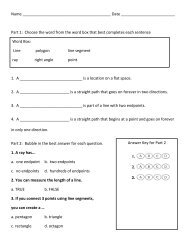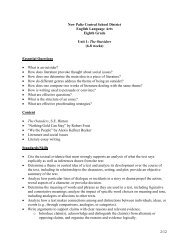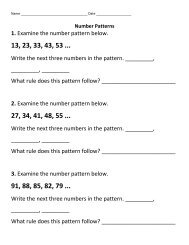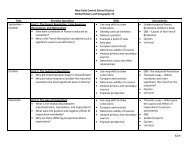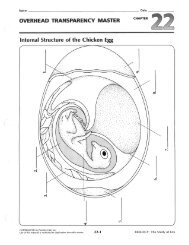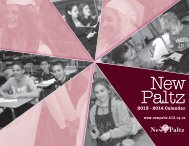Medieval Europe Quiz - New Paltz High School
Medieval Europe Quiz - New Paltz High School
Medieval Europe Quiz - New Paltz High School
- No tags were found...
You also want an ePaper? Increase the reach of your titles
YUMPU automatically turns print PDFs into web optimized ePapers that Google loves.
Base your answers to questions 1 and 2 on<br />
the art work below and on your knowledge of social studies.<br />
1. With which historical setting is this art work most closely associated?<br />
A) India—Mughal Empire B) Japan—Tokugawa shogunate<br />
C) Middle East—Abbasid dynasty D) Western <strong>Europe</strong>—Middle Ages<br />
2. Which economic system is most closely associated with the activities shown in this art work?<br />
A) capitalism B) socialism C) manorialism D) communism
3. Base your answer to question on the chart below and on<br />
your knowledge of social studies.<br />
What is the best title for this chart?<br />
A) Knights' Code of Chivalry<br />
B) Role of the Church<br />
C) Feudal Obligations<br />
D) Rules for Guild Membership<br />
4. An economic reason for the institution of serfdom was to<br />
maintain<br />
A) religious uniformity<br />
B) an educated citizenry<br />
C) overseas trade<br />
D) a stable workforce<br />
5. In the <strong>Europe</strong>an feudal system under manorialism, what<br />
is the most significant economic commodity?<br />
A) sugar and spices B) land<br />
C) gold and silver D) livestock<br />
6. Which document established the principle of limited<br />
monarchy in England?<br />
A) Magna Carta B) Twelve Tables<br />
C) Act of Supremacy D) Balfour Declaration<br />
7. Which political system is best described in the outline<br />
below?<br />
8. Letting some farmland remain unplanted as a means of<br />
increasing food production is most closely associated<br />
with<br />
A) the three-field system<br />
B) the enclosure movement<br />
C) modern irrigation methods<br />
D) slash-and-burn agriculture<br />
9. In western <strong>Europe</strong>, feudalism developed after the<br />
A) Mongols invaded<br />
B) Roman Empire collapsed<br />
C) city of Constantinople fell<br />
D) Renaissance began<br />
10. The term feudalism is best defined as a<br />
A) system in which land is exchanged for military<br />
service and loyalty<br />
B) holy war between Christians and Muslims<br />
C) process in which goods are traded for other goods<br />
D) division of political power between three separate<br />
branches<br />
I. ________________________<br />
A. Decentralized government<br />
B. Based on loyalty and service<br />
C. Code of chivalry<br />
D. Military elite<br />
A) Oligarchy B) Democracy<br />
C) Absolutism D) Feudalism
11. Base your answer to the following question on Base your answer to the following question on the drawing<br />
below and on your knowledge of social studies.<br />
What inference can be drawn from the location of the church in this drawing?<br />
A) The church controlled trade within the manor.<br />
B) The church played a limited role in education.<br />
C) Religion played a significant role in the lives of the residents.<br />
D) The mill was managed by the church.<br />
12. The terms masters, apprentices, and journeymen are<br />
most closely associated with the<br />
A) encomienda system of Latin America.<br />
B) guild system of <strong>Europe</strong> in the Middle Ages.<br />
C) caste system of India.<br />
D) civil service system of China during the Tang<br />
dynasty.<br />
13. In western <strong>Europe</strong>, the Middle Ages began after the<br />
collapse of which empire?<br />
A) Roman B) Byzantine<br />
C) Ottoman D) Mughal<br />
14. Both <strong>Europe</strong>an medieval knights and Japanese samurai<br />
warriors pledged oaths of<br />
A) devotion to their nation-state<br />
B) allegiance to their families<br />
C) service to their church<br />
D) loyalty to their military leader<br />
15. During the feudal period in <strong>Europe</strong>, power and position<br />
in society were based on the<br />
A) level of education achieved<br />
B) amount of land possessed<br />
C) amount of money earned<br />
D) number of slaves owned
16. Which practice in medieval <strong>Europe</strong> was most similar to<br />
a Japanese warrior’s code of bushido?<br />
A) chivalry B) serfdom<br />
C) tribute D) indulgences<br />
17. Feudalism influenced <strong>Europe</strong> and Japan by<br />
A) encouraging formal education<br />
B) providing social stability<br />
C) fostering the growth of religion<br />
D) eliminating warfare<br />
Base your answers to questions 18 and 19 on the<br />
illustration below.<br />
18. This illustration suggests that the <strong>Europe</strong>an feudal<br />
system was<br />
A) designed to promote political and economic<br />
equality<br />
B) supported by the labor of the peasants<br />
C) controlled by a powerful middle class<br />
D) intended to provide opportunities for social<br />
mobility<br />
19. The illustration represents a society based on<br />
A) educational achievement<br />
B) political ability<br />
C) social class<br />
D) accumulated wealth<br />
21. The Middle Ages in Western <strong>Europe</strong> was characterized<br />
by<br />
A) decreased emphasis on religion in daily life<br />
B) absolute monarchies and strong central<br />
governments<br />
C) extensive trade with Asia and the Middle East<br />
D) the manor system and the importance of land<br />
ownership<br />
22. Which is a characteristic of a feudal society?<br />
A) rigid class structure<br />
B) industrial-based economy<br />
C) high literacy rate<br />
D) rapid social change<br />
23. Which was a characteristic of feudalism?<br />
A) Unified national court systems were developed.<br />
B) Power rested in the hands of a strong central<br />
government.<br />
C) Land was exchanged for military service and<br />
obligations.<br />
D) Government was provided by a bureaucracy of<br />
civil servants.<br />
24. In western <strong>Europe</strong> during the early Middle Ages,<br />
education declined as a direct result of the<br />
A) loss of the power of the Christian Church<br />
B) rediscovery of classical Greek civilization<br />
C) fall of the Roman Empire<br />
D) rise of absolute monarchs<br />
25. <strong>Medieval</strong> life in <strong>Europe</strong> was characterized by<br />
A) rejection of the teachings of the Christian church<br />
B) a thriving system of international trade<br />
C) limited social mobility<br />
D) a strong central government<br />
20. Which factor contributed to the decline in the power of<br />
the <strong>Europe</strong>an nobles in the late Middle Ages?<br />
A) collapse of international trade<br />
B) increase in the influence of serfs<br />
C) decreasing importance of towns and cities<br />
D) rise of nation-states
26. Base your answer to the following question on the<br />
illustration below and on your knowledge of social<br />
studies.<br />
In both <strong>Europe</strong> and Japan, the major reason for the<br />
development of the political system shown in the<br />
illustration was to<br />
A) increase trade and manufacturing in the region<br />
B) provide order during a period of weak central<br />
governments<br />
C) consolidate the political power of religious leaders<br />
D) eliminate the need for a legal system<br />
27. In <strong>Europe</strong>an feudal society, an individual's social status<br />
was generally determined by<br />
A) individual abilities<br />
B) education and training<br />
C) marriage<br />
D) birth<br />
28. Which economic system existed in <strong>Europe</strong> during the<br />
early Middle Ages?<br />
A) free market B) socialism<br />
C) command D) manorialism<br />
29. The growth of feudalism in <strong>Europe</strong> during the Middle<br />
Ages was primarily caused by the<br />
A) suppression of internationalism<br />
B) collapse of a strong central government<br />
C) decline of the Roman Catholic Church<br />
D) rivalry between the colonial empires<br />
30. Which statement about the social structure in <strong>Europe</strong><br />
during the Middle Ages is most accurate?<br />
A) The nobles encouraged social mobility.<br />
B) The practices of the Catholic Church led to the<br />
development of a classless society.<br />
C) Industrialization led to the growth of socialism<br />
throughout <strong>Europe</strong>.<br />
D) Sharp class distinctions divided <strong>Europe</strong>an society.<br />
31. One similarity between the feudal manors of <strong>Europe</strong><br />
and the traditional villages of India is that<br />
A) peasants were seldom able to change their social<br />
status<br />
B) women dominated the political decisions of the<br />
local councils<br />
C) children could choose from a number of different<br />
occupations<br />
D) monarchs exerted absolute power over local<br />
governments<br />
32. Which institution served as the primary unifying force<br />
in medieval western <strong>Europe</strong>?<br />
A) militar B) legislature<br />
C) church D) monarchy<br />
33. During the early Middle Ages, western <strong>Europe</strong>an<br />
societies were most influenced by<br />
A) elected parliaments<br />
B) national monarchies<br />
C) the Byzantine emperors<br />
D) the Roman Catholic Church
34. Base your answer to the following question on “The<br />
Peace of God declared that feudal warfare could not<br />
take place on church property, and it promised<br />
sanctuary in churches and abbeys to fugitives from<br />
combat. The Truce of God forbade fighting from<br />
Wednesday evening until Monday morning, on<br />
holidays, and during the religious seasons of Christmas<br />
and Lent. . . .”<br />
— <strong>Medieval</strong> and Early Modern Times<br />
This quotation implies that<br />
A) the church had considerable political power during<br />
this time.<br />
B) landlords determined when warfare took place<br />
C) war was limited to religious holidays<br />
D) religion was dictated by feudal law<br />
35. Which statement best describes the role of the Roman<br />
Catholic Church in <strong>Europe</strong> during the Middle Ages?<br />
A) The Church gained influence as people became<br />
more interested in secular affairs.<br />
B) The Church encouraged individuals to question<br />
authority.<br />
C) Church leaders were involved only in spiritual<br />
activities.<br />
D) The Church provided a sense of stability, unity,<br />
and order.<br />
36. The Roman Catholic Church during the Middle Ages in<br />
<strong>Europe</strong> can best be described as a church that<br />
A) favored separation from secular governments<br />
B) was a strong force that divided many people<br />
C) avoided involvement in social and educational<br />
matters<br />
D) was a stabilizing influence during a period of<br />
weak central governments<br />
37. Which statement best describes society under<br />
the influence of medieval Christianity and traditional<br />
Islam?<br />
A) Religion played a major role only in the lives of<br />
the clergy.<br />
B) Both religions influenced society by stressing the<br />
equality of all religions.<br />
C) Religion permitted the freedom to choose how<br />
people would worship.<br />
D) Religion was a way of life that governed people<br />
from birth to death.<br />
38. Rome during the Pax Romana and the Catholic Church<br />
during the Middle Ages are examples of<br />
A) centralized powers<br />
B) feudal governments<br />
C) Communist regimes<br />
D) constitutional monarchies<br />
39. Base your answer to the following question on Base<br />
your answer on the quotations below and on your<br />
knowledge of social studies.<br />
"The pope is the only person whose feet are kissed by<br />
all princes. His title is unique in the world. He may<br />
depose [remove] emperors."<br />
— Pope Gregory VII (llth century)<br />
"An emperor is subject to no one but to God and<br />
justice."<br />
— Frederick Barbarossa,<br />
Holy Roman Emperor (12th century)<br />
The ideas expressed in these quotations show that<br />
during the Middle Ages in <strong>Europe</strong><br />
A) monarchs dominated the Church's leaders<br />
B) monarchs and popes strengthened the role of the<br />
Church<br />
C) popes and monarchs sometimes challenged each<br />
other's authority<br />
D) popes gave little attention to political matters<br />
40. Which style of architecture is characterized by<br />
stained-glass windows, tall spires, flying buttresses, and<br />
pointed arches?<br />
A) Corinthian B) Gothic<br />
C) Ionic D) neoclassical<br />
41. The art, music, and philosophy of the medieval period<br />
in <strong>Europe</strong> generally dealt with<br />
A) human scientific achievements<br />
B) religious themes<br />
C) classic Greek and Roman subjects<br />
D) materialism
42. Notre Dame Cathedral in Paris, the Dome of the Rock<br />
in Jerusalem, and the Great Pyramid in Egypt are<br />
examples of<br />
A) architectural accomplishments that reflect<br />
religious beliefs<br />
B) ancient architectural monuments no longer in use<br />
C) the influence of cultural diffusion on<br />
contemporary architecture<br />
D) the influence of Buddhist architecture on<br />
conquered nations<br />
43. During the <strong>Europe</strong>an Middle Ages, guilds were created<br />
to<br />
A) regulate the money supply<br />
B) increase competition<br />
C) standardize goods and prices<br />
D) obtain better working conditions in factories<br />
44. Which period in <strong>Europe</strong>an history is most closely<br />
associated with the emergence of trade fairs, the<br />
founding of guilds, and the creation of the Hanseatic<br />
League?<br />
A) Age of Pericles<br />
B) Glorious Revolution<br />
C) Commercial Revolution<br />
D) Age of Reason<br />
45. In <strong>Europe</strong> during the Middle Ages, increases in trade<br />
and commerce resulted in<br />
A) increased political power for the clergy<br />
B) lower living standards for industrial workers<br />
C) decreased economic rivalry between kings<br />
D) development of towns and cities



